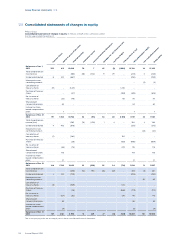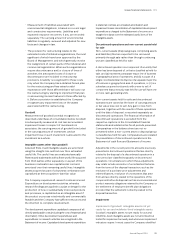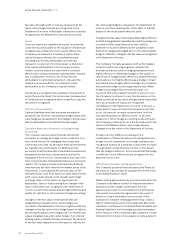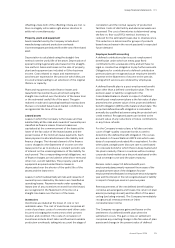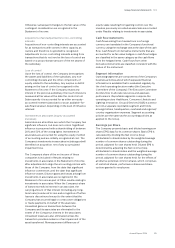Philips 2014 Annual Report Download - page 118
Download and view the complete annual report
Please find page 118 of the 2014 Philips annual report below. You can navigate through the pages in the report by either clicking on the pages listed below, or by using the keyword search tool below to find specific information within the annual report.Group nancial statements 12.9
118 Annual Report 2014
such information is not available, revenue recognition
is postponed until the return period has lapsed. Return
policies are typically based on customary return
arrangements in local markets.
In case of loss under a sales agreement, the loss is
recognized immediately.
Shipping and handling billed to customers is
recognized as revenues. Expenses incurred for shipping
and handling of internal movements of goods are
recorded as cost of sales. Shipping and handling related
to sales to third parties are recorded as selling
expenses. When shipping and handling is part of a
project and billed to the customer, then the related
expenses are recorded as cost or sales. Service revenue
related to repair and maintenance activities for goods
sold is recognized ratably over the service period or as
services are rendered.
A provision for product warranty is made at the time of
revenue recognition and reects the estimated costs of
replacement and free-of-charge services that will be
incurred by the Company with respect to the products.
For certain products, the customer has the option to
purchase an extension of the warranty, which is
subsequently billed to the customer. Revenue
recognition occurs on a straight-line basis over the
contract period.
Revenue from services is recognized when the
Company can reliably measure the amount of revenue
and the associated cost related to the stage of
completion of a contract or transaction, and the
recovery of the consideration is considered probable.
Royalty income, which is generally earned based upon
a percentage of sales or a xed amount per product
sold, is recognized on an accrual basis based on actual
or reliably estimated sales made by the licensees.
Grants from the government are recognized at their fair
value where there is a reasonable assurance that the grant
will be received and the Company will comply with all
attached conditions. Government grants relating to costs
are deferred and recognized in the Statement of income
over the period necessary to match them with the costs
that they are intended to compensate.
Income tax
Income tax comprises current and deferred tax. Income
tax is recognized in the Statement of income except to
the extent that it relates to items recognized directly
within equity or in other comprehensive income.
Current tax is the expected tax payable on the taxable
income for the year, using tax rates enacted or
substantially-enacted at the reporting date, and any
adjustment to tax payable in respect of previous years.
Deferred tax assets and liabilities are recognized, using
the balance sheet method, for the expected tax
consequences of temporary dierences between the
carrying amounts of assets and liabilities and the
amounts used for taxation purposes. Deferred tax is not
recognized for the following temporary dierences: the
initial recognition of goodwill, the initial recognition of
assets and liabilities in a transaction that is not a
business combination and that aects neither
accounting nor taxable prot, and dierences relating
to investments in subsidiaries to the extent that they
probably will not reverse in the foreseeable future.
Deferred tax is measured at the tax rates that are
expected to be applied to temporary dierences when
they reverse, based on the laws that have been enacted
or substantially-enacted by the reporting date.
Deferred tax assets and liabilities are oset if there is a
legally-enforceable right to oset current tax liabilities
and assets, and they relate to income taxes levied by
the same tax authority on the same taxable entity, or on
dierent tax entities, but they intend to settle current
tax liabilities and assets on a net basis or their tax assets
and liabilities will be realized simultaneously.
A deferred tax asset is recognized for unused tax losses,
tax credits and deductible temporary dierences, to the
extent that it is probable that future taxable prots will
be available against which they can be utilized. The
ultimate realization of deferred tax assets is dependent
upon the generation of future taxable income in the
countries where the deferred tax assets originated and
during the periods when the deferred tax assets
become deductible. Management considers the
scheduled reversal of deferred tax liabilities, projected
future taxable income, and tax planning strategies in
making this assessment.
Deferred tax liabilities for withholding taxes are
recognized for subsidiaries in situations where the
income is to be paid out as dividend in the foreseeable
future and for undistributed earnings of unconsolidated
companies to the extent that these withholding taxes
are not expected to be refundable or deductible.
Changes in tax rates are reected in the period when
the change has been enacted or substantially-enacted
by the reporting date.
Provisions
Provisions are recognized if, as a result of a past event,
the Company has a present legal or constructive
obligation that can be estimated reliably, and it is
probable that an outow of economic benets will be
required to settle the obligation. Provisions are
measured at the present value of the expenditures
expected to be required to settle the obligation using a
pre-tax discount rate that reects current market
assessments of the time value of money. The increase
in the provision due to passage of time is recognized as
interest expense. The accounting for some of the
Company’s provisions is as follows:
• A provision for warranties is recognized when the
underlying products or services are sold. The
provision is based on historical warranty data and a
weighing of possible outcomes against their
associated probabilities.








